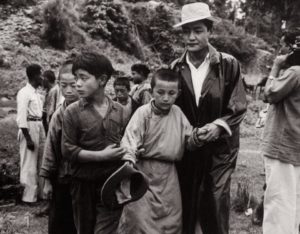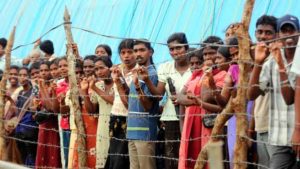Guests of Destiny: Refugees in India
In South Asia, India is devoted to sustaining a tolerant, democratic and secular regime in a neighborhood of unstable, volatile and religious states, welcoming people seeking asylum.
E

very nation-state has experienced major and minor refugee crises in past and still continues to face them, and India is no exception. The birth of the country itself occurred in the midst of one of the biggest such crises the world has ever seen. India’s diversity and stability have attracted people fleeing persecution and instability in their own countries. The birth of India accompanied by one of the most intense illustrations of migration. Millions were displaced during this partition as Hindus and Sikhs moved to India while Muslims moved to Pakistan. A lot of refugee camps across north India served as homes mostly in Delhi meanwhile an extended Faridabad was built to rehabilitate refugees.
The next major movement of refugees towards India happened almost a decade after partition in 1959, when the Dalai Lama, along with followers, fled Tibet and came to India seeking political asylum. Granting asylum to them on humanitarian grounds substantiated costly to India, earning the rage of China. In 1971, Around 10 million people moved into India from East Pakistan mainly in West Bengal, Assam, and Tripura during the war. The civil war of 1983 in Sri Lanka forced the departure of nearly 700,000 Tamilians in next 20 years largely in southern India. India also served as home for many other communities which include Afghans, Somalia, and Iraq. It also hosts a small group of Syrian refugees who wished to avoid the strains of going to overcrowded camps in neighbouring countries or Europe. Though, the distance between the two countries has made it hard for more Syrians to take refuge here.
In South Asia, India is devoted to sustaining a tolerant, democratic and secular regime in a neighborhood of unstable, volatile and religious states. India continues to receive refugees notwithstanding its own over-a-billion population with at least six hundred million living below poverty line with partial access to basic amenities. However, the Indian legal structure has no uniform law to deal with its huge refugee population and has not made any improvement towards developing one either. It chooses to treat incoming refugees based on their national origin and religious and social considerations, questioning the uniformity of rights and privileges granted to refugee communities.
“The kind of issue I can discuss with someone from another country and place constantly amazes me. So it doesn’t matter where one is from, but common human bond can really bring people together. Working with refugees has taught me this, and this is one of the experiences I treasure most.” Kavita, Cafe owner based in refugee colony, Khirkee Extension, Delhi

Indeed, the National Human Rights Commission (NHRC) has submitted several reports urging the declaration of a national law, or at least, making changes or amendments to the outdated laws and act which deal with citizenship and refugees like the Foreigner’s Act (1946) and The Registration act (1939). The primary and most significant void in these laws is that they do not contain the term ‘refugee’ consequently, under Indian Law, the term ‘foreigner’ and ‘alien’ is used. This broad category deprives them of the rights available under the various international Convention. The ad hoc nature of the Government’s approach has led to the varying treatment of different refugee groups. In India time and again illegal immigrants have been used by vote-seeking parties to secure a majority in the central and the state legislatures. All these refugee populations deserve their basic human rights and the assistance that can be afforded by the Government of India.
“Every year millions of people are forced to flee their homes because of conflict, violence, and persecutions. Faced with uncertain future, many of those displaced cross national borders in search of safety and security. They should have access to a human right. India has continued to host a significant number of refugees feeling from neighboring countries and other parts of the world. But there is no proper guideline to govern them. I have met many people who have been in India for many years, but they spend most of the time waiting for some or other documents. Now in India many civil societies are working with the government to improve the condition and remove barriers for them. But it is a long way to go.” Aru Bose, Activist and Social Worker
Regardless of domestic and international criticism and pressure, India is not a signatory to the 1951 Convention relating to the status of refugees or the 1967 Protocol. This makes India’s international position disputable in terms of treatment of refugees. However, it is equally significant to note that India is a signatory to various other international and regional treaties and conventions relating to universal human rights and refugees such as the UN Deceleration on Territorial Asylum (1967), the Universal Declaration of Human Rights, and the International Convention on Civil and Political Rights. India is also a member of Executive Committee (ExCom) of the UNHCR which approves and supervises the material assistance programmes of the UNHCR.
India should have stricter laws with regard to the refugee crisis, but signing the convention is not practically possible, because most of India’s neighbours have not signed the convention. This makes India the only option for the refugees to seek asylum, so, without any cooperation from the neighbouring countries and from other economically developed countries, India will solely bear the burden of the entire subcontinent. But this does not prevent India from lending a hand in the humanitarian crisis. India has treated the refugees in the best manner possible. This includes granting rights to own property for self-occupation, seek self-employment, getting Registration Certificates (RC) to get traveling papers for abroad and owning cattle and domestic supply items. In the absence of a national legal framework for refugees, UNHCR conducts refugee status determination under its mandate for asylum seekers who approach the Office. The two largest groups of refugees recognized by UNHCR are Afghans and Myanmar nationals, but people from countries as diverse as Somalia and Iraq have also sought help from the Office. Many refugees can now apply for long-term visas (LTVs) issued by the Government of India, based on UNHCR documentation. This includes the right to work in the private sector and access to education facilities in India. However, possibilities for more government intervention never end.
The photo used in the slider of refugees fleeing credits to photographer Raghu Rai.
